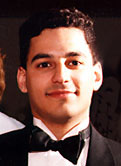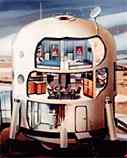|
David Santiago
–
visual effects artist
|

|
"
I typically use an engineering analysis approach to everything. This works whether designing a Mars community, making a movie, or cooking a large meal."
|

|
| |
|
|
|
| |
How were you motivated to become a visual effects artist? |
| |
Growing up I was always involved in artistic endeavors. My school had
art and music requirements every year. I voluntarily took wood shop from
third until eleventh grade,but I was also subjected to art classes in drawing, printing, carving,ceramics, painting, pen & ink, and more. I was not very good and,
although I enjoyed the creative endeavor, the results discouraged me. I understood the concepts, but my mind and hands had trouble in the implementation. I dreaded going to
art class. The only thing I could draw relatively well (proper scale, perspective, etc.), whether it be pencil, pen & ink, or charcoal, was architecture.
I have always loved theater and performing and was involved with plays,
musicals, bands and choirs from third grade until my senior year in high
school. I helped design, build and paint sets for many school productions besides singing and dancing in them. With my particular drawing, construction and
performance skills, theater seemed like the appropriate artistic direction for me.
I also loved math and science. I wanted to know how everything worked
and math problems were puzzles to be solved. My classes taught me the
foundations for proper research and experimentation. As it came time to go to college, I knew I wanted a mix of math and science for problem solving so engineering
was the way to go. Electronics and computers were a hobby since the 4th grade so I chose electrical engineering with the possibility of specializing in biomedical since I
loved biology as well.
During college my engineering classes kept me pretty busy and in my free time I chose to pursue intramural sports, work with student organizations and enjoy time with my
new friends. I was interested in space and had many discussion with my
aerospace enginering friends, but never thought I would be involved with
the space program until the Jet Propulsion Laboratory offered me a job. Space became more
interesting as I worked to support of its exploration, and the various
engineers and scientists who were now my friends explained their research to me.
At JPL, I was involved with many "extracurricular" activities to balance
the engineering part of my life. I played sports, pursued many outdoor
activities like backpacking, sang with the Caltech Glee Club, and was involved with some theater groups – Theatre Americana (TA) and Theatre Arts at the California
Institute of Technology (TACIT). Besides enjoying the technical and artistic sides of theatre, I also go to work with many creative and talented people. My theatrical
activities grew until I was working on plays in Hollywood, videos and low budget and student films. After six and a half years of engineering as a career with entertainment as a hobby, I had the opportunity to make my hobby my career and vice versa.
Digital Domain, a visual effects company, had hired a fellow JPL/theater enthusiast a year before and had found it was easier to teach an artistic engineer/scientist the art tools
for digital effects than it is to teach a traditional artist the math and physics required to create realistic natural phenomena. So Digital Domain spoke with several of us at JPL
and some of us decided to join them to create the lava for Dante's Peak. For now, it is a good combination of the technical and artistic for me.
|
|

|
| |
|
|
|
| |
What can you share about your creative process? |
| |

|
|
It depends on what I am working on, but I typically use an engineering
analysis approach to everything. This works whether designing a Mars
community, making a movie,
or cooking a large meal.
The point of visuals effects, or the set for a play or movie is to help
tell the story or convey the theme the director has in mind. Using
engineering problem solving
techniques, even artistic choices and needs can be broken down into
quantitative or qualitative specifications. It's best when this begins
early in pre-production or the planning
phases for a project. This way the dialogue begins among all the
technicians and artists on the team who need to work together to create
the final product. They all need to be
clear on common goals and parameters like budget and schedule. In
conceptualizing the goals for the project a common language is often
developed to bridge the gap
between the the many expertises of the team.
I believe in teamwork, but each individual must be allowed to develop
the areas under his particular expertise before bringing them to the
group for discussion, modification
and implementation. Be prepared for the modifications. Be general and
flexible in designs to be able to accomodate the full range of
possibilities of the original contraints
and then some. When it comes to final design for implementation, then
we can streamline the design for efficiency, keeping only the features
needed to satisfy the project
goals.
|
|
| |
|
|
|
| |
What ideas do you have for a future human community on Mars?
|
| |
I don't know if any of these ideas are unique, but my vision of a
community on Mars is very pragmatic and less fanciful than most. Most
designs you see for Martian or
Lunar communities have an artist's "futuristic" look about them with
domes, spires, tubes, etc. My vision for a first planetary colony is
low to the ground. Simple landing
pads which dock craft to a series of interconnected environmentally
secure mobile homes. On their roof tops are solar panels, power plants
and the various other equipment
needed to maintain the human habitat inside. These habitats will extend
into the martian soil at least a story.
|
|

|
|




